| Columns Retired Columns & Blogs |
Sennheiser Noise Canceling Headphones: PXC 550 Wireless; HD 4.5 BTNC; HD1 Wireless; and HD1 On-Ear Wireless
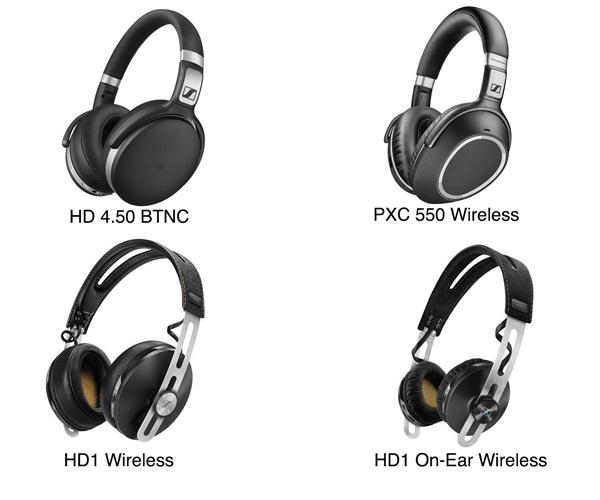
This story originally appeared at InnerFidelity.com
About this time last year I reviewed the then new Sennheiser PXC 550 BTNC over-ear, noise canceling headphones in hopes that someone would manage to unseat the Bose Quiet Comfort 35. Didn't happen. The Sennheiser had some great features, but in the end it was just too bright for me.
Recently I got a few more Sennheiser wireless noise cancelers and I found they too seemed overly bright. Now I consider Sennheiser the world's best headphone manufacturer. They've got a lot of experience under their belt, so when I hear a batch of Sennheisers, from differing product lines, that all seem too bright and have a quite similar measured response, I've got to question myself. Maybe they know something that I don't.
The thought that came to mind is that maybe wireless noise canceling headphones for consumers should be a little brighter than neutral in order to keep speech intelligibility high in loud environments. Maybe watching YouTubes and making phone calls are particularly aided by a different sort of response.
So, I sent in a question that was basically a short version of the following observations asking whether it was an intentional tuning that is thought to be superior for consumer mobile phone use.
Sennheiser PXC 550 ($399)
Here's the measurements from the PXC 550 I reviewed last year.
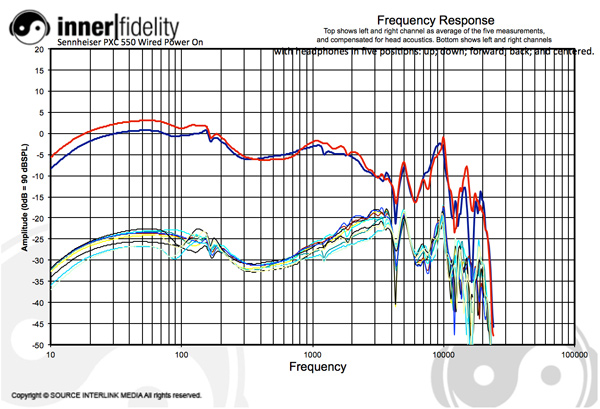
This headphone has no wired mode without the electronics on so there may be some electronic tuning going on here, but in the raw plot above (lower traces) notice the rise from 500Hz to the peak at 3.5kHz. I call this the presence region (above 800Hz anyway) and in my experience it should be a gentler rise until about 1.2kHz and then steepen to the peak, which in this case is about the right height at about 12dB above the baseline level. You can also see in the compensated plot (upper traces) that the plot bulges upward in this area. This is a clear sign to me that these cans will sound forward, and they did.
Also note the narrow dip at 4kHz and subsequent sharp peak at 5kHz. At first I thought this might just be a notch to tune out something undesired in this range but, as we'll see below, this feature is common to a number of these headphones.

The above plot is the PXC 550 wired with noise canceling active. You can see that there's some tuning done to flatten out and extend the bass response, but the strong presence region and 4kHz notch and 5kHz peak remain.
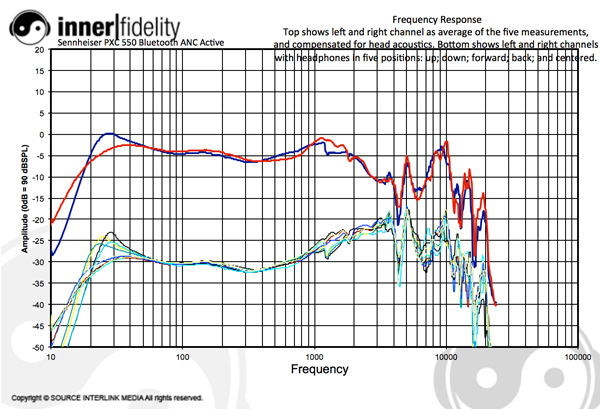
Response is similar with noise canceling in Bluetooth mode. Additionally we see a sharp peak sometimes appearing at 20-30Hz. This is a common artifact for noise cancelers as they fight to keep bass response in the presence of slight leaks in the ear pad.
Sennheiser HD 4.50 BTNC ($199)
Here's a more recent, and less expensive offering.
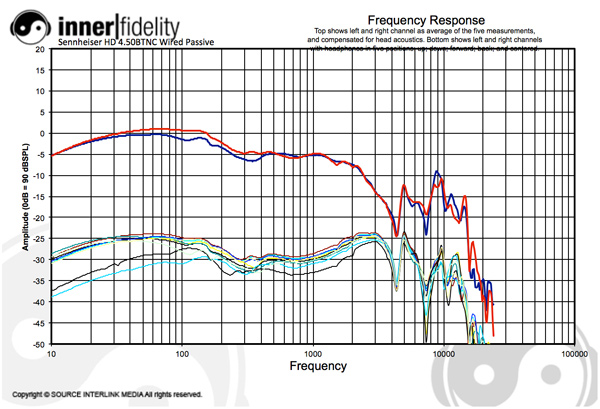
Wired with no electronics on we can see the basic passive response of the headphone. It's a little bass heavy, but tastefully so. The peak at 3kHz may be a little low in level, but the run-up to it is a nice upwardly curving plot. Oddly—and I say oddly because this is in passive mode and matches the PXC 550 plot—the notch at 4kHz and peak at 5kHz is present. This is something done by the passive acoustic response of the headphone and, because it's common to two of the other cans here, I can only assume is by design.

Now in wired mode with the noise canceling electronics on, we again see a linear run-up to from 300Hz to the peak at 2.2kHz. The peak is a little low in frequency, but is now a full 15dB or more above the level at 300Hz. These sounded like a fairly bright/forward headphone to me. The notch/peak at 4-5kHz remains, and is even a bit stronger than in passive mode. The bass has also been reshaped, though I think this may be a reasonable bass response for some listeners.

Here off the wire but with noise canceling off, you can see the response is more like the wired, passive mode—though the inconsistant bass response indicates I was having a hard time getting these cans to seal—which can be seen in various degrees with all measurements of this headphone.

Turning the noise canceling on in Bluetooth mode and we see the return of the strong presence region; strong peak at 2.2kHz; and 4-5kHz notch/peak.
Sennheiser HD1 M2 AEBT ($499)
Flagship of the Sennheiser wireless noise canceling line is the reincarnated Momentum over-ear headphone, the HD1 M2 AEBT. (Headphone one, Momentum 2, around-ear Bluetooth, I assume.)

In wired passive mode this headphone clearly resembles the wired, non-noise canceling modes of both above headphones.
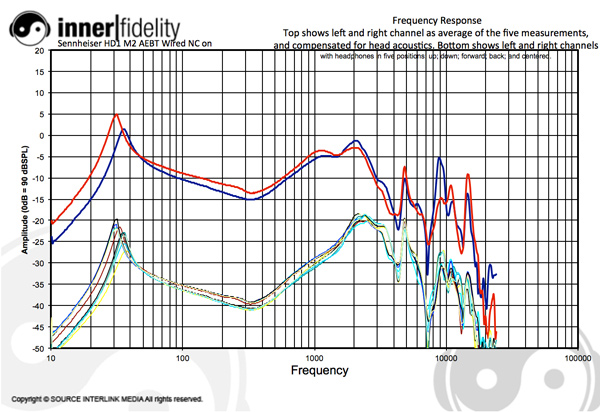
But turn the noise canceling mode on while wired and we now get the linear run-up with a huge 20dB peak at 2.2kHz! The bass is now even more exaggerated. In listening the bass didn't bother me too much...probably because it did a little something to take my attention away from the significantly bright presence region. The 4-5kHz notch/peak remains.

Off the tether with noise canceling on was much the same.
Sennheiser HD1 On-Ear Wireless ($399)
The only on-ear of the group, the HD1 On-Ear Wireless was a little different.
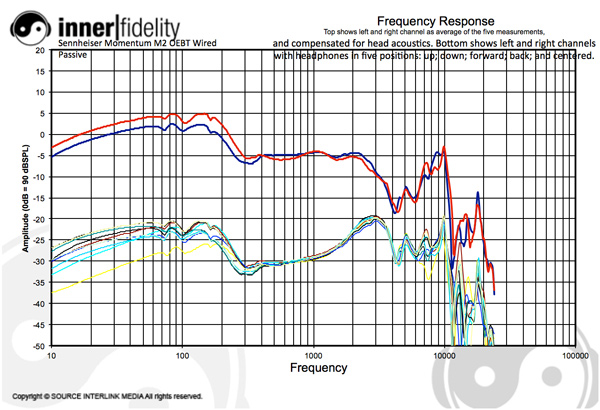
Notice the 4-5kHz trough/peak has disappeared. Other than the bass boost intruding a bit on the low-mids this is a pretty good looking response, and I heard it as the best of the bunch.

But go wireless and we see the return of the linear rise to a 5dB higher peak at 3kHz, and a big bass boost.

Once noise canceling is active response is much the same above 400Hz, but we see some significant artifacts from the difficulty of sealing with an on-ear and the noise canceling circuit working to deliver bass.
Conclusions
My first question to Sennheiser went unanswered...so did the second...and third...and fourth...
I have no idea why Sennheiser likes that linear run-up to the 3kHz peak. Nor do I know where the 4-5kHz trough/peak is coming from. In the absence of a definitive answer from Sennheiser I'm left to speculate.
I tried these cans for YouTube watching and phone calls in loud environments, and I found them all too forward for comfortable listening, they were just too bright. If Sennheiser thinks this is a better tuning for mobile use I'll just have to disagree.
I would guess that the 4-5kHz trough/peak is coming from the internal noise canceling microphones mounted in front of the drivers. I have noticed this type of feature elsewhere and have come to think that when you put an obstruction right in front of the driver you get a feature like this.
My uninformed guess is that Bose noise canceling patents force Sennheiser to do things in less than optimal ways and the above response profiles arrise as a result. I wish Sennheiser would have filled me in.
Ah well.
Measurement Spreadsheets
PXC 550 wired, wired NC on, wireless with noise canceling.
HD 4.50 BTNC wired passive, wired NC on, wireless, wireless NC on.
HD1 M2 AEBT wired passive, wired NC on, wireless NC on.
Momentum M2 OEBT wired passive, wired NC on, wireless NC on.
- Log in or register to post comments




































